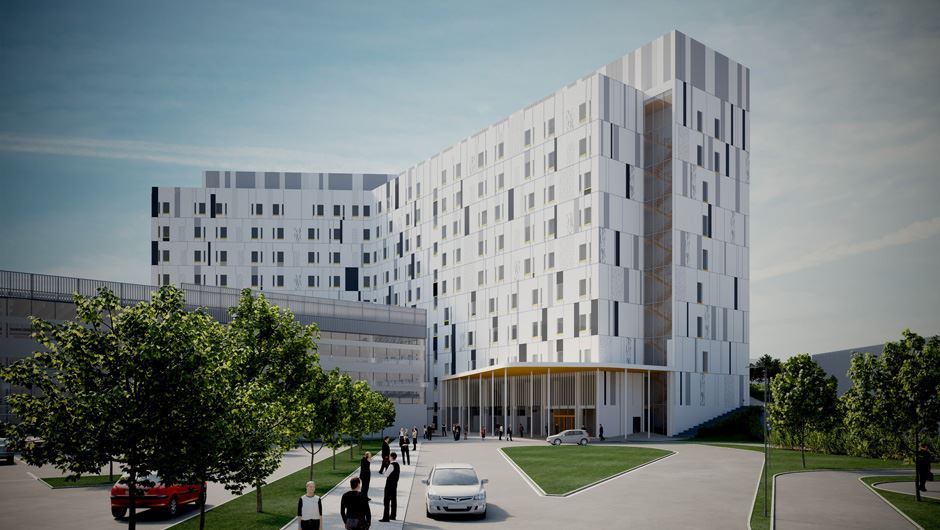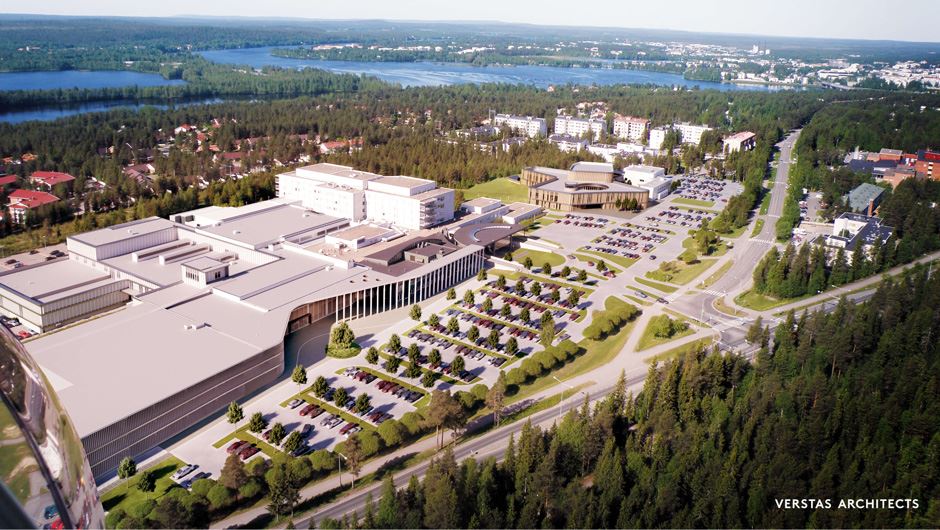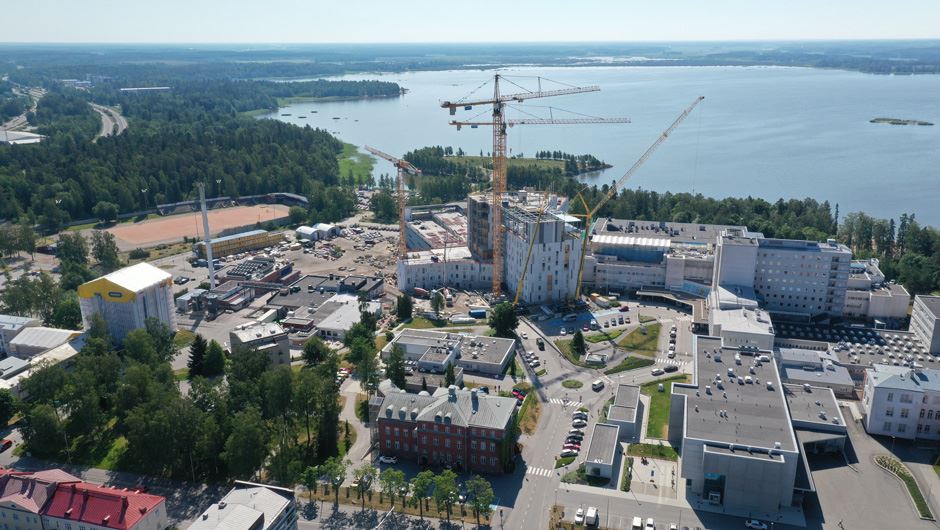Sustainable data centers as a service
- Construction
- 9/16/2020
The construction of a hospital requires teamwork
Hospital construction projects are often large and complex. The cooperation model has proven to be effective in implementation. The involvement of the builder and the utilisation of their expertise from the very beginning of the planning phase brings many benefits to the project.

Large hospital projects require special expertise from their contractors, the ability to operate in a changing operating environment, and good operating models and information management tools. A prerequisite for success is seamless cooperation with representatives of the future users and other parties.
“In hospital construction, in addition to ensuring health care processes and the logistical functionality of the hospital area, high quality requirements and humidity and cleanliness management are emphasised. The actual construction does not differ so much from other business premises construction processes. The biggest differences are the large number of functions located on the site and the requirements they set for technology and conditions,” says Janne Kananen, Project Development Manager at YIT.
“There are a lot of technical systems in hospital buildings. It is important for the builder to have a holistic understanding of the requirements of the management processes and the objectives of the project in order to guide the planning and implementation.”
The builder ensures the feasibility of the plans
In cooperation implementation methods, such as the alliance model, the builder is involved from the beginning and gives his own know-how to the project already at the planning stage. The builder helps to ensure that the plans are feasible, on schedule, cost-efficient, and that the quality is in line with the objectives.
According to Janne Keskinarkaus, Lapland Hospital District's Project Director, the builder is the best party to take a position on whether the planned solutions are reasonably feasible.
“In the expansion project of the Lapland Central Hospital, YIT has been able to bring us alternative material and implementation solutions. Through this, we have achieved significant savings for the project without compromising on the end result,” says Keskinarkaus.

YIT's Project Development Manager Jaakko Linnolahti emphasises the added value of the builder's expertise in implementation options, cost-efficiency, and budget stability.
“We provide the customer with different implementation options at the planning stage, reflecting the objectives. From them, a cost-efficient compromise is chosen to take into account the entire lifecycle of the building. This saves time and money. Thanks to building information modelling and comprehensive procurement expertise, we get the most accurate cost estimate possible for the project, which means that sticking to the budget is more successful,” says Linnolahti.
Aiming for optimal value for tax money
The cooperation model is an ideal implementation form for a long-term hospital project. The key players in the project are jointly responsible for planning and implementation.
The parties work closely together, share the risks and benefits of the project, and adhere to the principles of transparency of information. Together, the alliance strives for an optimal value for money, which is more than the cheapest price. It is the ratio of benefits – such as customer orientation, flexibility to transform facilities, a smart hospital, quality, and sustainable lifecycle – to the price and risks at which the benefits are achieved.
“In the new H Building project for Vaasa Hospital District, the planning is only somewhat ahead of the implementation. Thanks to simultaneous planning and implementation, the building will be completed faster. We will have access to the H Building approximately 18 months sooner than with a traditional construction project model. We do need a new building. Impractical facilities in bad repair serve health care processes and customer orientation poorly,” says Timo Koivisto, Real Estate Engineer at Vaasa Hospital District.

Constantly changing operating environment
The builder of a hospital operates in a constantly changing operating environment as the hospital's health care processes and functions evolve and must be taken into account in construction. Development work is ongoing during the project, so changes require a clear process that covers the approvals of representatives of the user, the client and the contractor. The role of cooperation is emphasised.
The aim is to prepare for future changes related to the use of the building as well as possible. The building and its structure are designed to adapt to the development of functionalities, purposes or technical systems during its service life.
In practice, this means, for example, structural solutions that allow changes in the use of spaces in exceptional situations such as a pandemic, or that plans for technical building systems are prepared to utilise future technology.
Moving safely and smoothly in the hospital area
New hospital buildings are often located in existing hospital areas. In construction, special emphasis is placed on the safety of the area and the functionality of logistics. The flow of customers and personnel, as well as ambulance traffic, must be smooth.
Managing material flows on site is another issue. There are a lot of deliveries that require good forward planning, arrangements and communications from the constructor.
Koivisto states that signs and passageways are the most visible part of the construction for those who visit the hospital.
“In Vaasa Central Hospital area, we have been able to keep the temporary routes the same throughout the H Building construction project. This is really important for the safety of the hospital area and the smooth flow of traffic,” says Koivisto.
In the expansion project for Lapland Central Hospital, a new section will be built as an attachment to the existing hospital. The operations of the hospital must be taken into account at all times, breaks must not occur without prior warning.
“We have done really well at that. Of course, all work phases have to be completed, and sometimes it is necessary to cause some disturbance. YIT foremen have taken care of this so well and visited the site in advance to agree on matters with our personnel,” says Keskinarkaus.
Read more on the hospital projects in this article:
The H Building of the Vaasa Central Hospital
Lapland Central Hospital expansion
**
The new H Building of Vaasa Central Hospital is being constructed by the Bothnia High 5 alliance. The Bothnia High 5 alliance consists of Vaasa Hospital District, Ramboll Finland, Granlund Pohjanmaa, Raami Architects, Kontukoski Architects, and YIT. For more information, please visit the project website.
The ITU project, in other words, the expansion project of Lapland Central Hospital, is implemented using an alliance model. In addition to Lapland Hospital District, the alliance members include Verstas Architects, Granlund, Geobotnia, WSP and L2 Fire Safety Ltd, Are, and YIT. For more information, please visit the project website.
The following people have been interviewed for the article:
Janne Keskinarkaus, Project Director, Lapland Hospital District
Timo Koivisto, Real Estate Engineer, Vaasa Hospital District, construction
Jaakko Linnolahti, Project Development Manager, YIT
Janne Kananen, Project Development Manager, YIT



